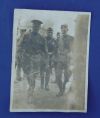
| Original WW 1 Photo of General "Blackjack" Pershing |
This is an original photograph taken during World War One of General Pershing who commanded the AEF, American Expeditionary Forces in France. Its only a guess, but this photograph was probably taken in 1918. Its a good action photo of Pershing at the height of his military career and gives you a slight feel for what France must have been like during WW 1. You can even see the dirt and mud on their boots. Overall, the photo is in pretty poor shape with some discoloration and some blurring to the right side which is either from the development process or light damage...nonetheless, you can see the hard lines and disciplined determination in Pershing's face under the brim of his hat formed by decades of military service in the United States Army. He is walking with his staff through a gauntlet of American soldiers standing at attention. If you look closer, you will see one of these Doughboys is armed with a Model 1903 Springfield rifle. The back of the photograph is hand-written in ink, "General Pershing" and "Colonel Van Arden". In terms of assignments which spanned through 4 decades on both American and Foreign soil, there probably isn't a more interesting American soldier within a half-century span of American History. After graduating from West Point in 1886, Pershing first took his first command in the 6th US Cavalry participating in the final stages of Geronimo's capture. In 1890, Pershing led a group of Sioux scouts in the Dakotas and participated in the Wounded Knee campaign. By the early 1890's he was given command of the 10th Cavalry, the famous African American Cavarly Units known as the "The Buffalo Soldiers." During the Spanish American War Pershing and the 10th Cavalry fought along-side of Teddy Roosevelt's 1st Volunteer Cavalry units earning Pershing an important friend in years to come. His Colonel was so impressed by his demeanor in combat that he extolled, "I have been in many fights, through the Civil War, but Captain Pershing is the coolest man under fire I ever saw in my life." In 1899, Pershing was sent to the Phillipines where he was given a new command in which he helped suppress the Moro Uprisings. For the next ten years, he held several foreign assignments and started a family in which he and his wife had 3 daughters and one son. Tragically, his wife and 3 of his 4 children died in the fire at the Presidio in 1915 with only his son surviving. They say this is when his hair turned white and the hard lines in his face appeared which you can see in this photo. In 1916, Pershing was given command during the Mexican Expedition which crossed into Mexico in search of Pancho Villa. When America entered World War One, Pershing was given his most recognized command, Commander of the AEF. He really had a tough job getting an Army raised and over to Europe...there were a tremendous amount of logistics involved which was quite an accomplishment. Once the bulk of the AEF got to France in 1918, Pershing had the tough task of trying to keep the American Army whole and not dispersed throughout the French and British Armies. This did happen to some extent during a major German offensive but by September 1918, Pershing was given command of the American Army as a whole once again. Pershing led the AEF to victory during the Meusse Argonne offensive by breaking through the German lines and blocking communications. This played a considerable role in helping trap the German Army between the French and British forces which ended the war . Pershing retired from the Army in 1924 and lived until 1948. He is buried at Arlington National Cemetary with his two grandsons. Not the best photograph of Pershing but you won't find many "in-the-field" photos of U.S. commanders like this one. Not to mention, this picture was taken at the pinnacle of Pershing's entire military career. Item# 0234 $50.00 SOLD |
 |
 |
 |
|